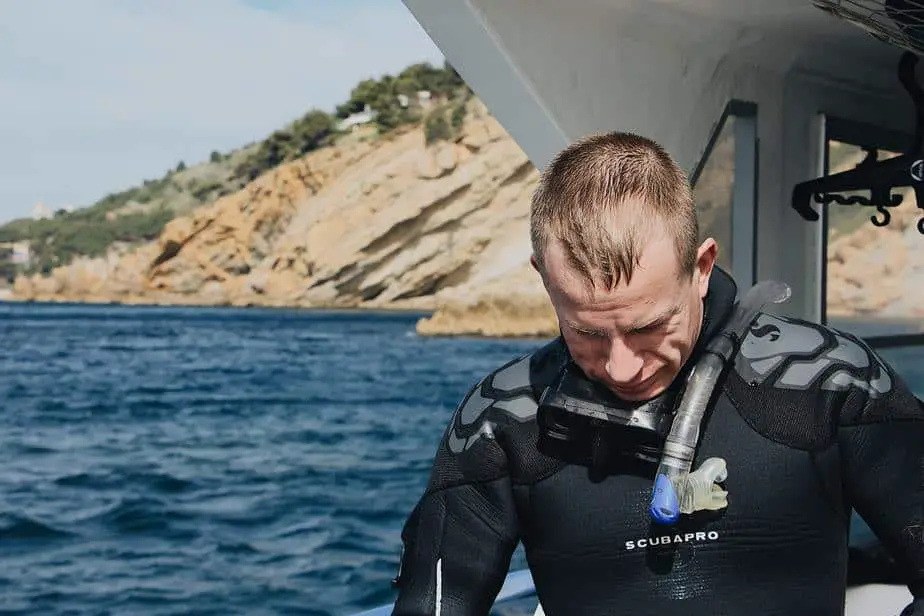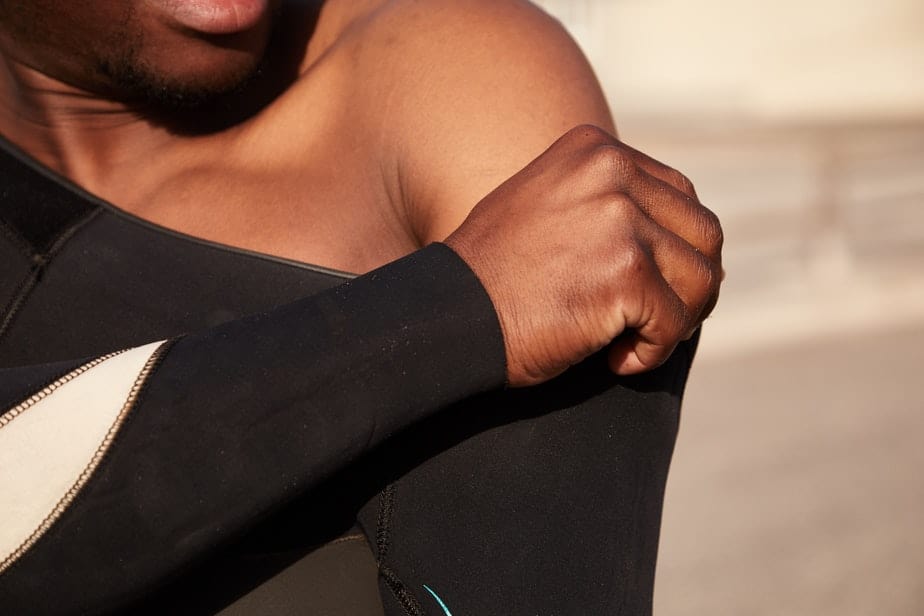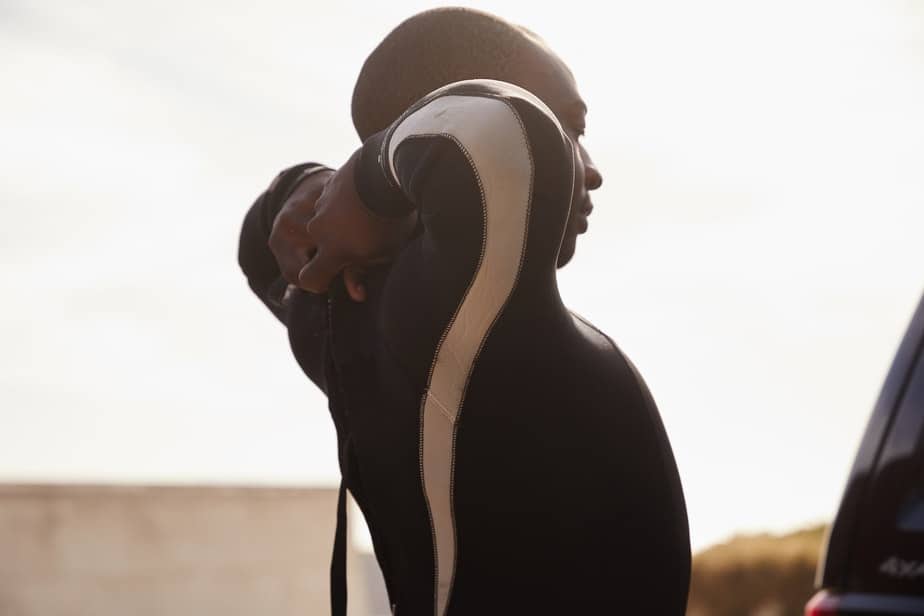If you are in the market for your first wetsuit, it can be difficult figuring out how tight a wetsuit is supposed to fit. The material and design of a wetsuit is so different from regular clothing that most buyers struggle to figure out if it’s too tight or loose. Sometimes you may think you have the right fit on land, but once you enter the water, you realize that you’re not getting insulated much or at all.
So how tight is a wetsuit supposed to be? Wetsuits are often referred to as a “second skin”. The skin analogy is very apt. Think of your own skin – is it always stretched taut or is it somewhat stretchy? A well-fitting wetsuit follows a similar idea – it must be tight but not too tight. If you feel like you’re suffocating or can barely move a muscle, it’s too tight. Conversely, if it’s too loose, you will feel like you are being weighed down, water is flooding in, and you can see folds on the wetsuit. You also have to consider the arm and leg length of the wetsuit, not just the tightness.
As you can see, it’s very difficult to figure out if a wetsuit fit is correct or not without actually trying it on. In this article, we will give first-time wetsuit buyers some much needed fits to help you judge whether a wetsuit is a good fit for you or not.
Is the wetsuit doing its job?

Before digging into the nitty-gritty of how well a wetsuit fits, you must remember the primary reason for getting a wetsuit which is to keep you warm, and any other benefits are secondary. They are NOT intended to keep you dry, so don’t think a fit is bad just because water is entering.
In case you are not familiar with how a wetsuit works, the material that a wetsuit is constructed out of, neoprene, has bubbles trapped inside it which are excellent at insulating your body heat. When a thin layer of water enters the wetsuit, the water gets warmed up because most of the heat is unable to escape through the suit, so they remain trapped and heat up the water, effectively creating a thin barrier of warm water around your body.
If the wetsuit is too tight, this essential layer of warm water is not able to enter, and you will not feel as warm. Conversely, if your wetsuit is too loose, the water layer will never be able to warm up because it is constantly being flushed out by cold water. The result is that you might as well not even wear a wetsuit because it’s doing nothing for you.
To recap, it’s normal for water to enter the wetsuit. It needs to be at a slow enough rate that the water trapped inside the wetsuit can warm up and maintain your core temperature. However, there will always be some warm water leaking out and getting replaced by new water that needs to get warmed up. This is fine, as long as the rate of warm water loss does not exceed the rate new water is entering. How well your wetsuit fits directly affects this balance act..
This is also the reason why one can pee in their wetsuit – the pee is not trapped inside your wetsuit. It will eventually be replaced by new water. Just make sure to thoroughly rinse your wetsuit after for sanitary reasons. You probably can’t get away with doing a number 2, however, nor do we recommend trying.
Wetsuit sizing

As we mentioned, wetsuit sizes are not the same as normal clothing sizes. Also, the sizes may be slightly different depending on which manufacturer you are buying from. The best way to get the most accurate sizing information is to check the specific sizing chart of that wetsuit.
Sizing charts are just a guideline. You can also read customer reviews to get an idea of whether you should size up or size down. The sizing chart and customer reviews are the most accurate starting points you can get aside from literally trying it on yourself.
One thing to keep in mind is that you should focus on the chest measurement first. For ladies, do not simply refer to your bra size; actually get a measuring tape and measure your chest for the most accurate results. Then you should take into account your height and weight.
Another factor to consider is your body type. Everyone will be slightly different; there is nobody that perfectly meets the criteria for “average”. For instance, you may have a longer torso and shorter legs or vice versa. You might have wider shoulders than normal. You might have a flat chest or be barrel chested.
Women have more options here because if they aren’t content with how the women’s wetsuits are fitting them, they can try men’s wetsuits instead. We generally recommend getting a wetsuit that is designed for a specific sex over a unisex one. The general consensus seems to be that unisex wetsuits are the worst of both worlds.
For instance, women’s wetsuits will take into account a woman’s shape, particularly in the bust and hip area. A unisex wetsuit would likely feel very uncomfortable because it cannot be too shapely otherwise it won’t be as suitable for men. Men might feel that there is not enough space in the crotch area, and so on.
Tips for getting the right fit

How can you tell if a wetsuit is too small? We need to look out for warning signs that it might be too tight. If you feel like your circulation is being cut off, or that you cannot perform the movements you need to perform, then it’s probably too tight.
Keep in mind, there is a difference in the type of wetsuit you are wearing. For instance, a surfing wetsuit is going to be more flexible than a scuba wetsuit. However, it’s intentional for a scuba wetsuit to sacrifice some mobility for extra insulation since the cold is more of an issue than mobility while scuba diving. If you engage in multiple sports, we recommend getting a specific wetsuit for each sport.
Another factor to consider is how hard it is to put on a wetsuit. If you are putting on a wetsuit for the first time, don’t be surprised if it takes you a few minutes. This is because wetsuits are supposed to fit tight. It will become easier to put on as you break it in and you get better at donning your wetsuit. Make sure both you and your wetsuit are dry for an easier time.
Think of donning your wetsuit like putting on a pair of tight jeans. It can take some effort to put on, but once it’s on, you should not feel like blood flow is being restricted to your legs or that the pant legs are preventing you from moving. Same concept with a wetsuit. If it feels more like you’re wearing a cast, it’s too tight.
It’s not a big deal if the arms and legs of the wetsuit are a little long. The most important part is how it fits your torso. Wetsuit manufacturers tend to make the arms and legs extra long so that wetsuit buyers have the option of trimming off the excess.
Another important area is the collar. Too tight, and it will feel like something is constantly choking your neck. Too loose, and water will flood in. Plus, it will cause a lot of drag while you’re swimming.
Make sure the butt and crotch area isn’t too loose. Fellas and ladies, don’t be afraid to show off your stuff. Again, the wetsuit needs to be tight. Yes, there will be somewhat of a visible bulge. Don’t be shy about it. If the crotch and butt area is too loose, it will be a pocket where water can accumulate which increases drag. As long as the wetsuit doesn’t restrict your range of motion while keeping those areas snug, then it’s a good fit.
How a two-piece wetsuit should fit
Another wetsuit option to try out is the two-piece wetsuit. Two-piece wetsuits feature a pullover top and a bottom that is similar to overalls. Two-piece wetsuits may provide more mobility and may be easier to put on.
Similar to sizing a one-piece wetsuit, you want both pieces of your two-piece wetsuit to fit snug on your body. Another name for a two-piece wetsuit is Farmer John suits, and they are favored by spearfishermen because of their added maneuverability.
Two-piece wetsuits tend to be bulkier than a one-piece and typically provide better insulation, especially around your torso. They usually have a hood attached to the top piece, which can drastically decrease heat loss. Again, the hood should fit snug without feeling like it’s choking you or causing you head strain.
Wetsuit hacks to don them easily

If you are really struggling to put on your wetsuit, there are some “hacks” you can try out before you throw in the towel.
Plastic bag trick
Did you know that a plastic bag can help you put on your wetsuit? Start by sticking your hand/feet into the bag, then push into the sleeve or leg. The plastic bag should reduce the friction and make it easier to slide through. This trick can help you get your arms and legs inside the wetsuit. Once that’s done, it should be much easier to wiggle your torso around until you have a snug fit.
Use soapy water
We generally recommend that you put on your wetsuit dry, because water actually increases the friction. However, if you combine water with shampoo, then it becomes like a lubricant, helping you slide your arms and legs inside easily. Make sure to lather your arms and legs and the wetsuit with this soapy water to ensure everything is evenly coated to facilitate a faster donning process.
Does a wetsuit naturally stretch?

Yes. Another reason why it’s okay for the wetsuit to be a little tight is that it will gradually loosen as you break it in. Also, neoprene will stretch when exposed to water, so wetsuits do get a little bigger when wet. These are the appropriate ways to stretch out a wetsuit.
What you don’t want to do is to forcibly stretch it yourself by hand because you want your tight wetsuit to fit a little looser. This will cause certain areas to become much looser than others, and you may even tear or at least decrease the integrity of the neoprene. This is also a very important consideration when storing and drying your wetsuit.
We have written an article on how to dry and care for your wetsuit which you should read after this one. When storing your wetsuit, do not put anything heavy on it because it can damage the neoprene. Furthermore, many people hang their wetsuit completely wrong by using a standard clothes hanger and leaving it directly in the sunlight. This is a surefire way to decrease the wetsuit’s lifespan.
You should hang it using a specific wetsuit hanger that is much thicker, or place it on a drying rack that will not cause any creases. Wetsuits can get really heavy when they are wet, and a regular clothes hanger will put tremendous pressure on the shoulder area, stretching or creasing them in a way that deteriorates the material quality.
Parting words

It can be tough to get a wetsuit that fits your body shape perfectly, but if you follow the tips provided in this article, it should get you started on the right foot.
Remember that a wetsuit’s primary job is to keep you warm and comfortable, as if it were a second protective layer of skin around your body. The wetsuit should fit you tight and snug without constricting your blood flow or severely restricting your movement. The wetsuit should also not rub against your skin uncomfortably as that can lead to a wetsuit rash.
Conversely, a wetsuit should not be so loose that it has loose folds or allows water to flush out the warm water inside. If you feel like cold water keeps entering the wetsuit, then that wetsuit is quite useless at its job. With these goals in mind, it becomes easier to find the right wetsuit size.
Consult the wetsuit sizing chart provided in the sales page. This is your best starting point. Pay particular attention to the chest measurement, followed by the height and weight measurements. These are the most likely areas that will make or break a wetsuit fit. Also read the customer reviews to see if you should size up or down.
If you are struggling to put on the wetsuit the first few times, it doesn’t mean that the fit is bad. You can try using the plastic bag trick or the soapy water hack to put it on more easily. Also, the wetsuit will naturally stretch over time as you break it in, so don’t try to stretch it by hand.
Lastly, be very specific with the wetsuit you get. Don’t get some generic unisex wetsuit. If you are a male and you want to go surfing, get a surfing wetsuit for men. There is a difference between wetsuits designed for different sports. It’s perfectly fine for a scuba wetsuit to be more restrictive than a surfing wetsuit and that is not a design flaw. With these tips in mind, you can get the perfect wetsuit for your body shape.

